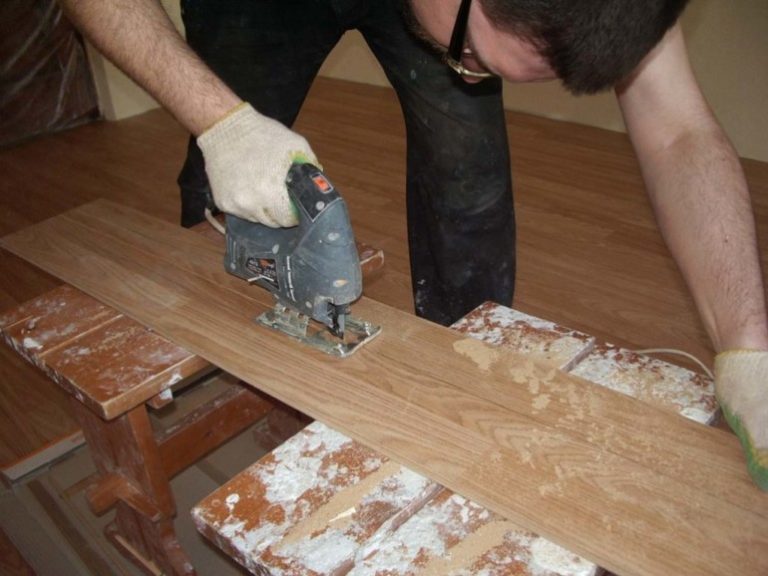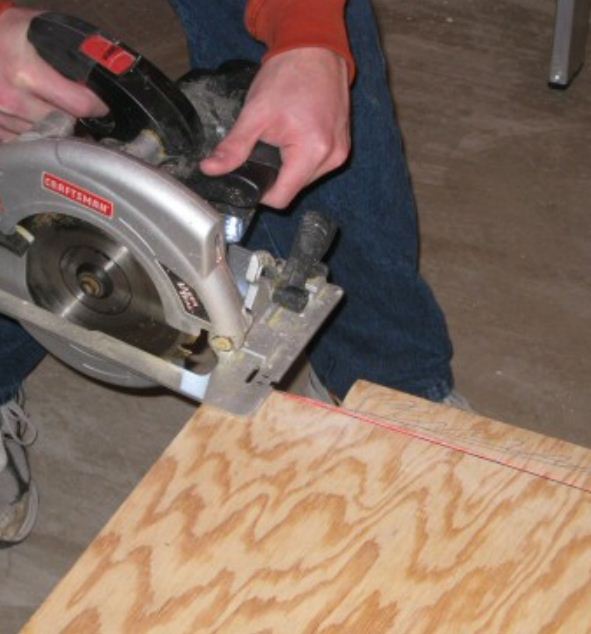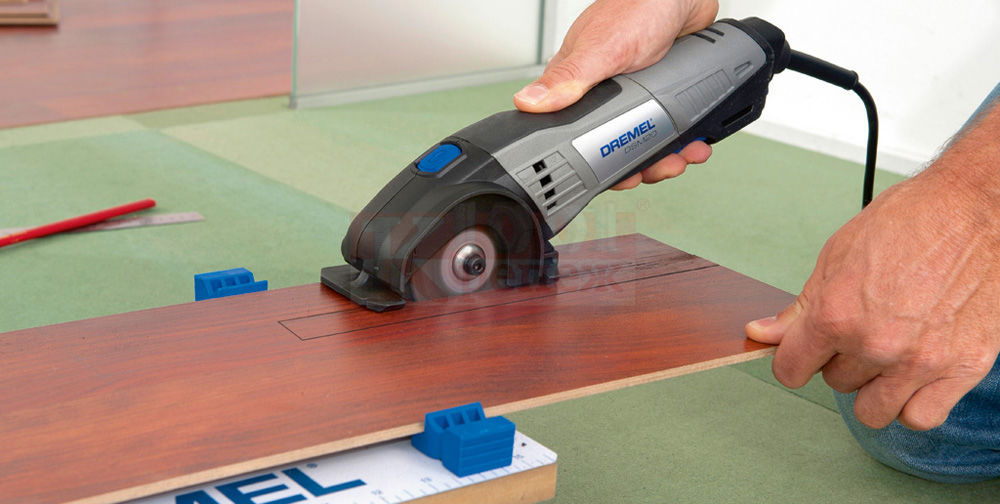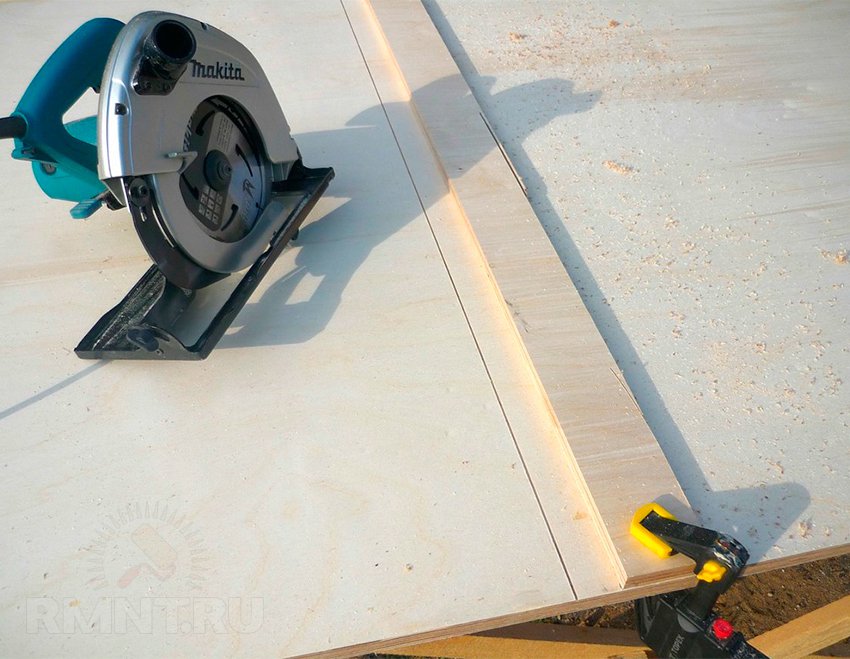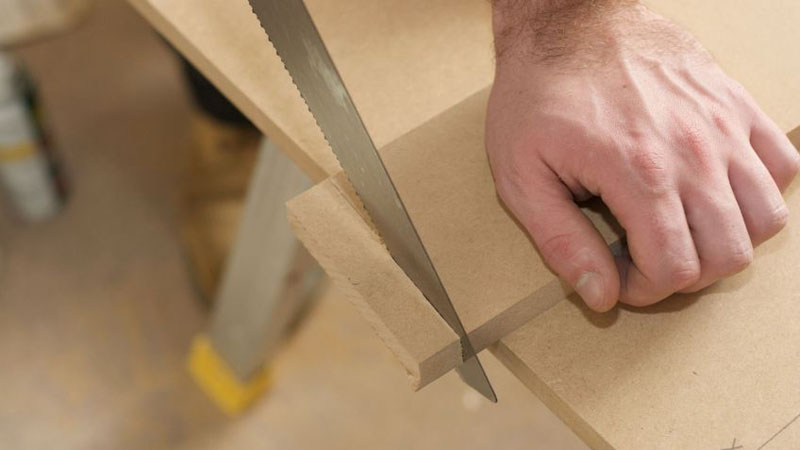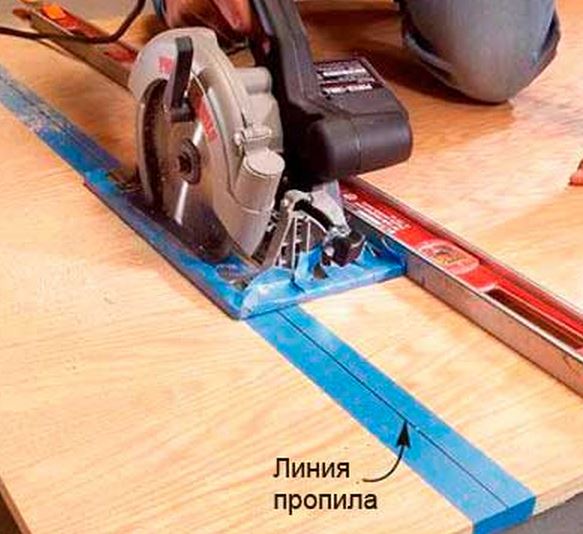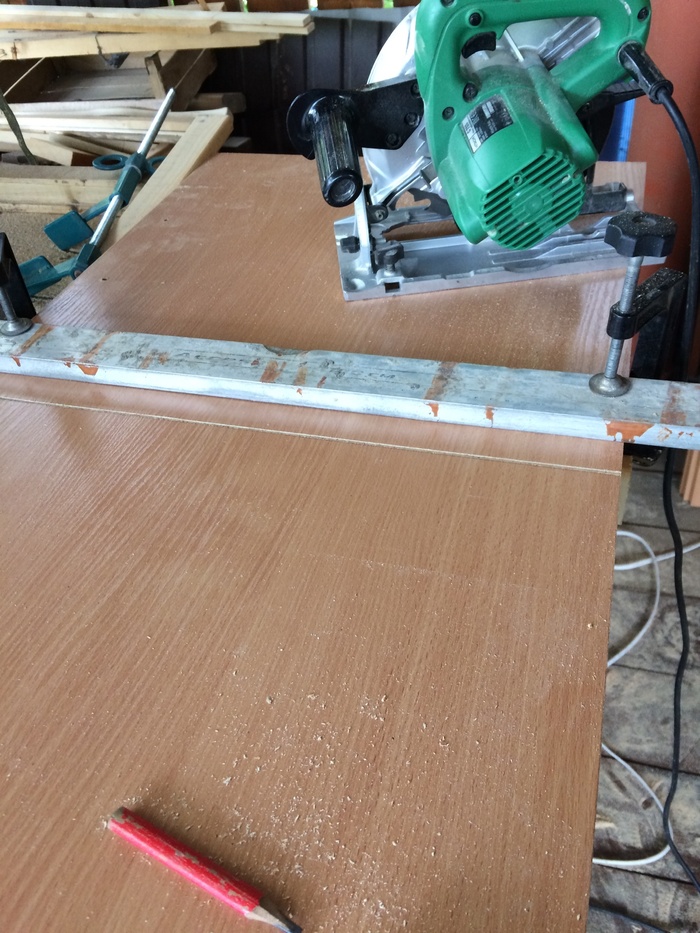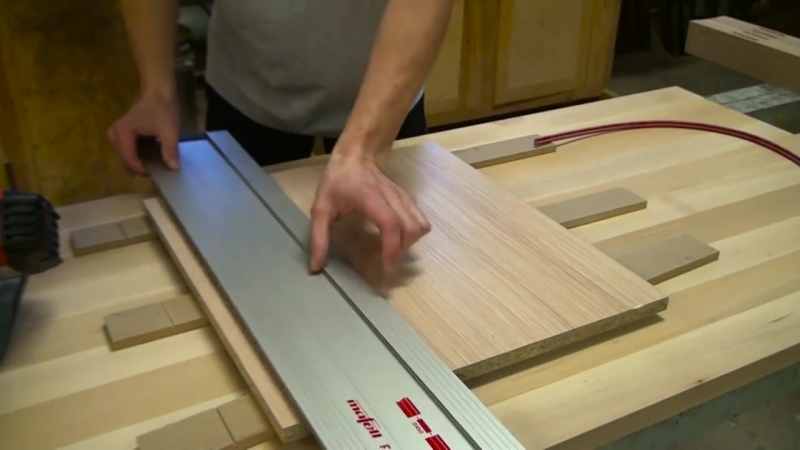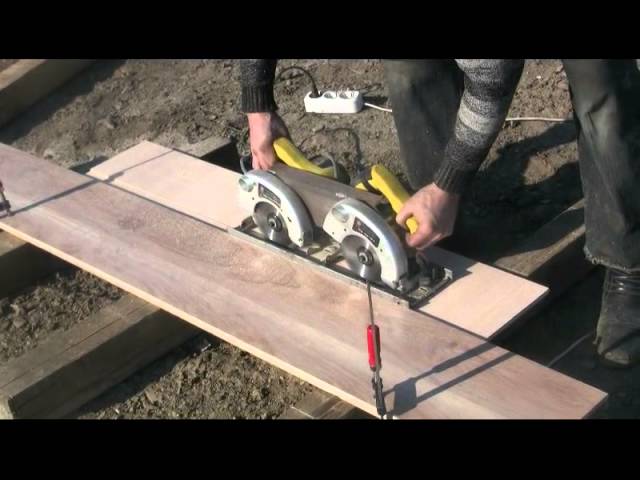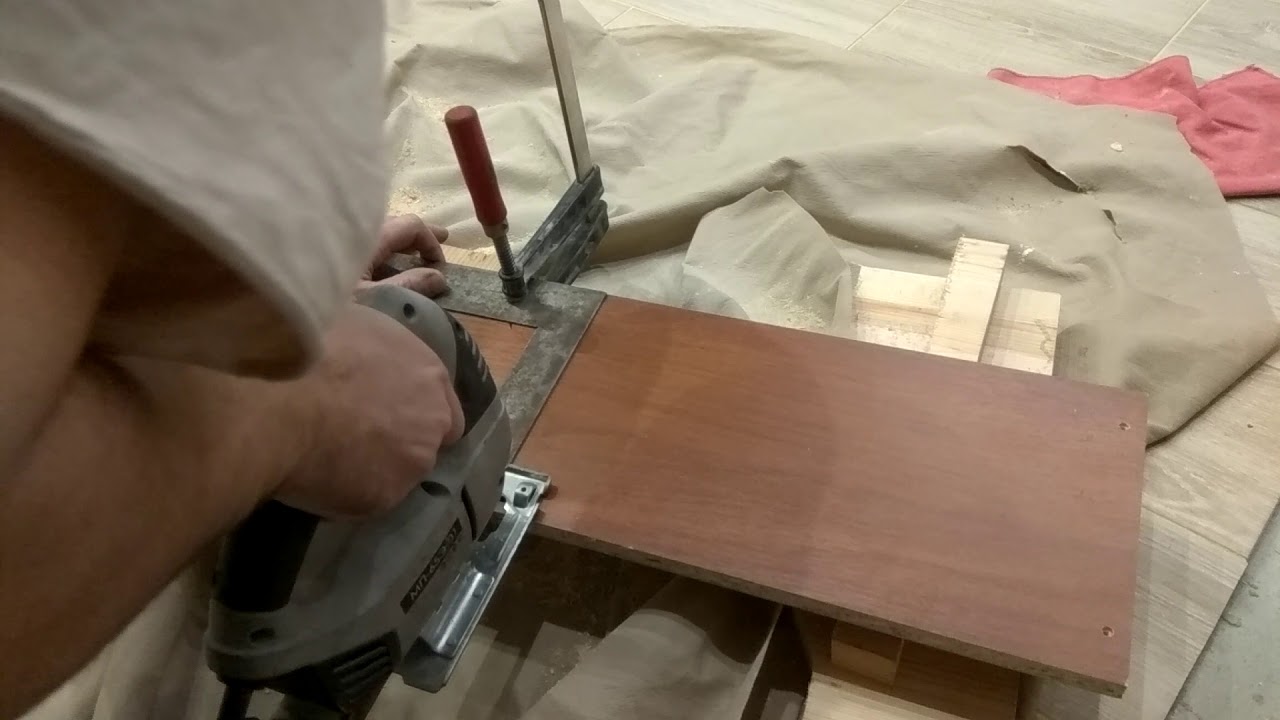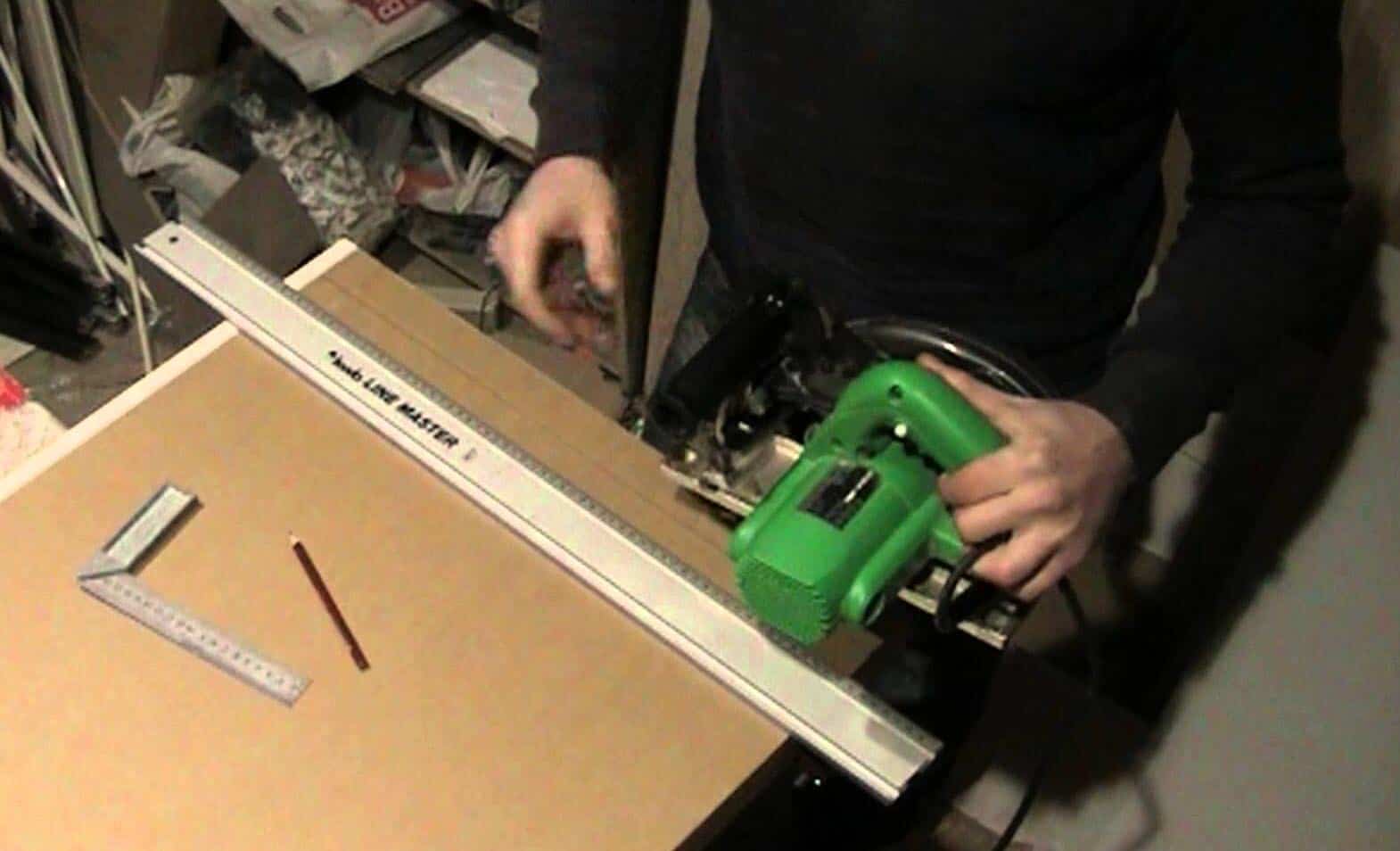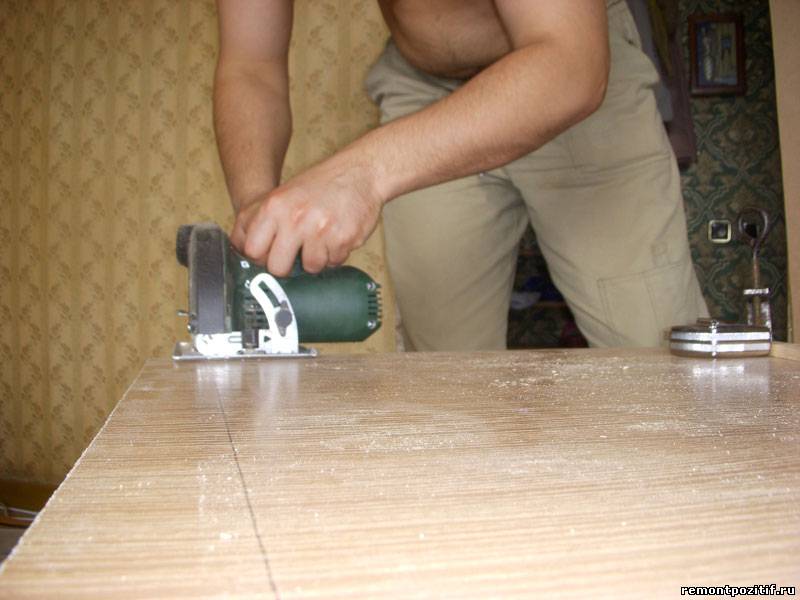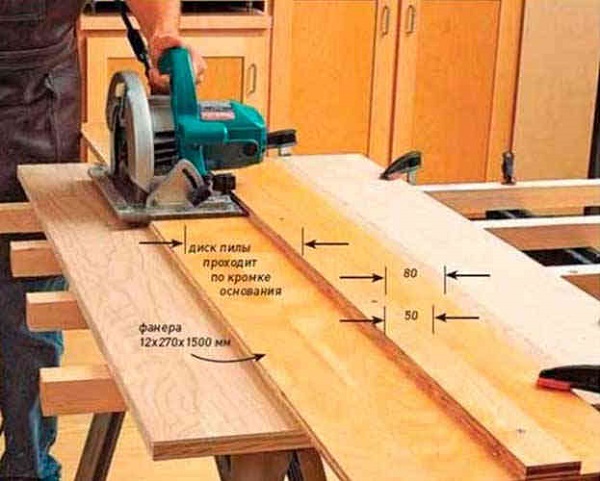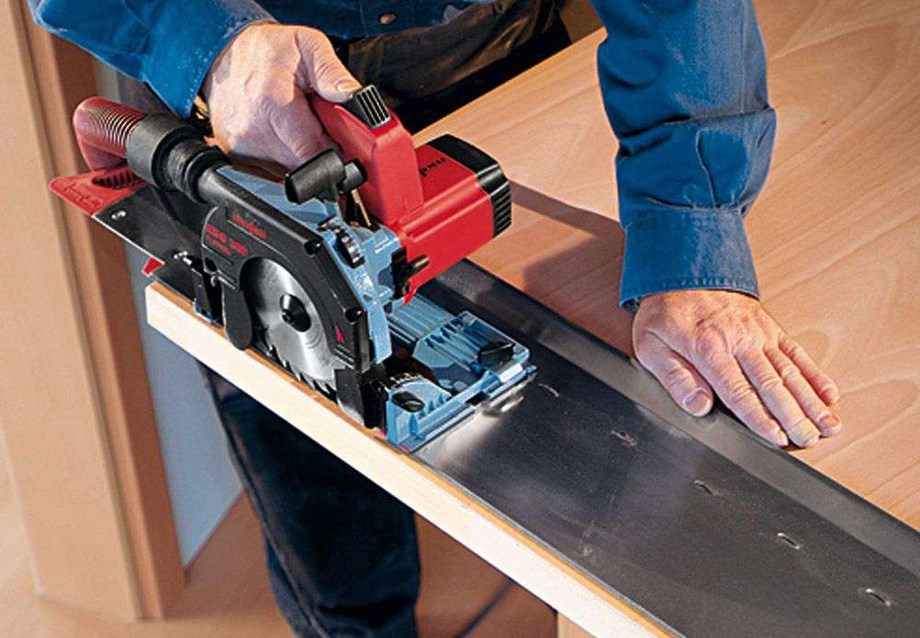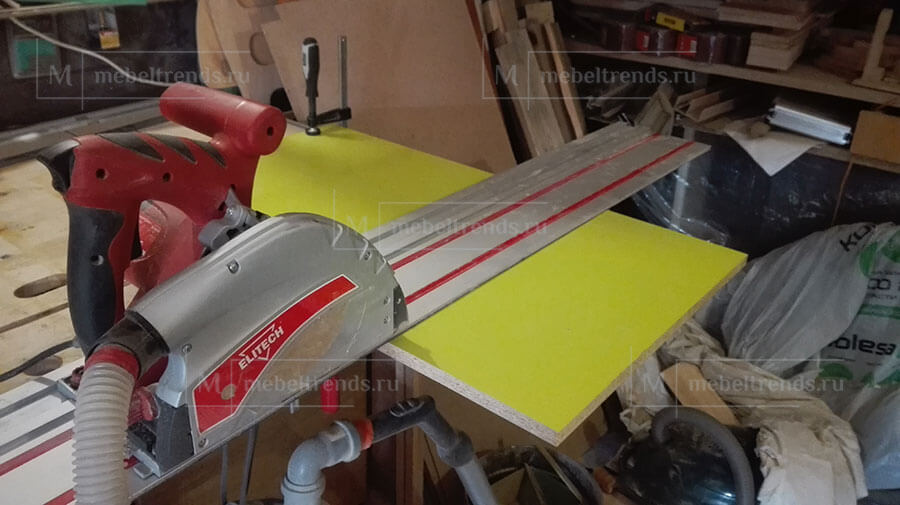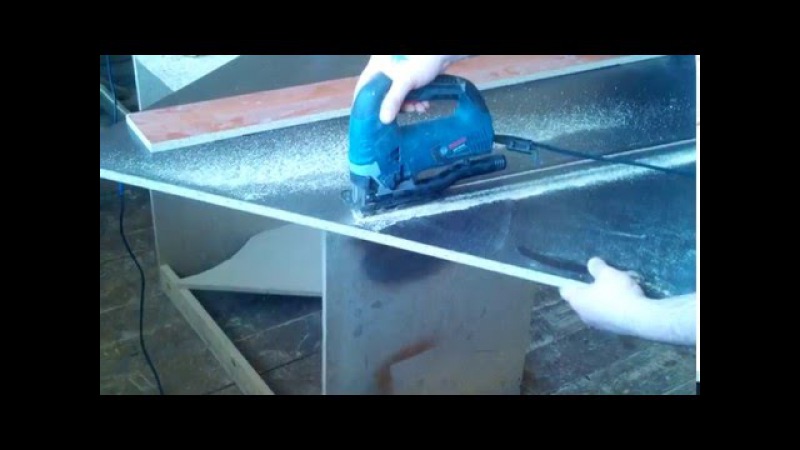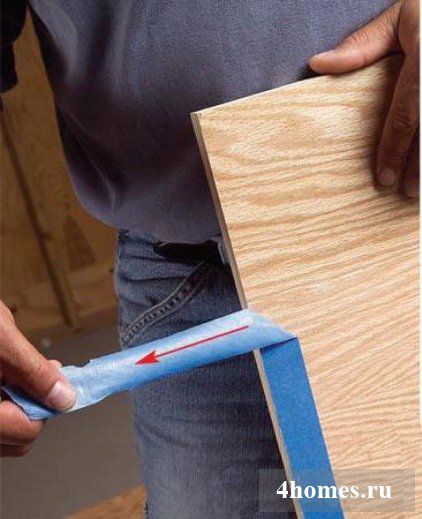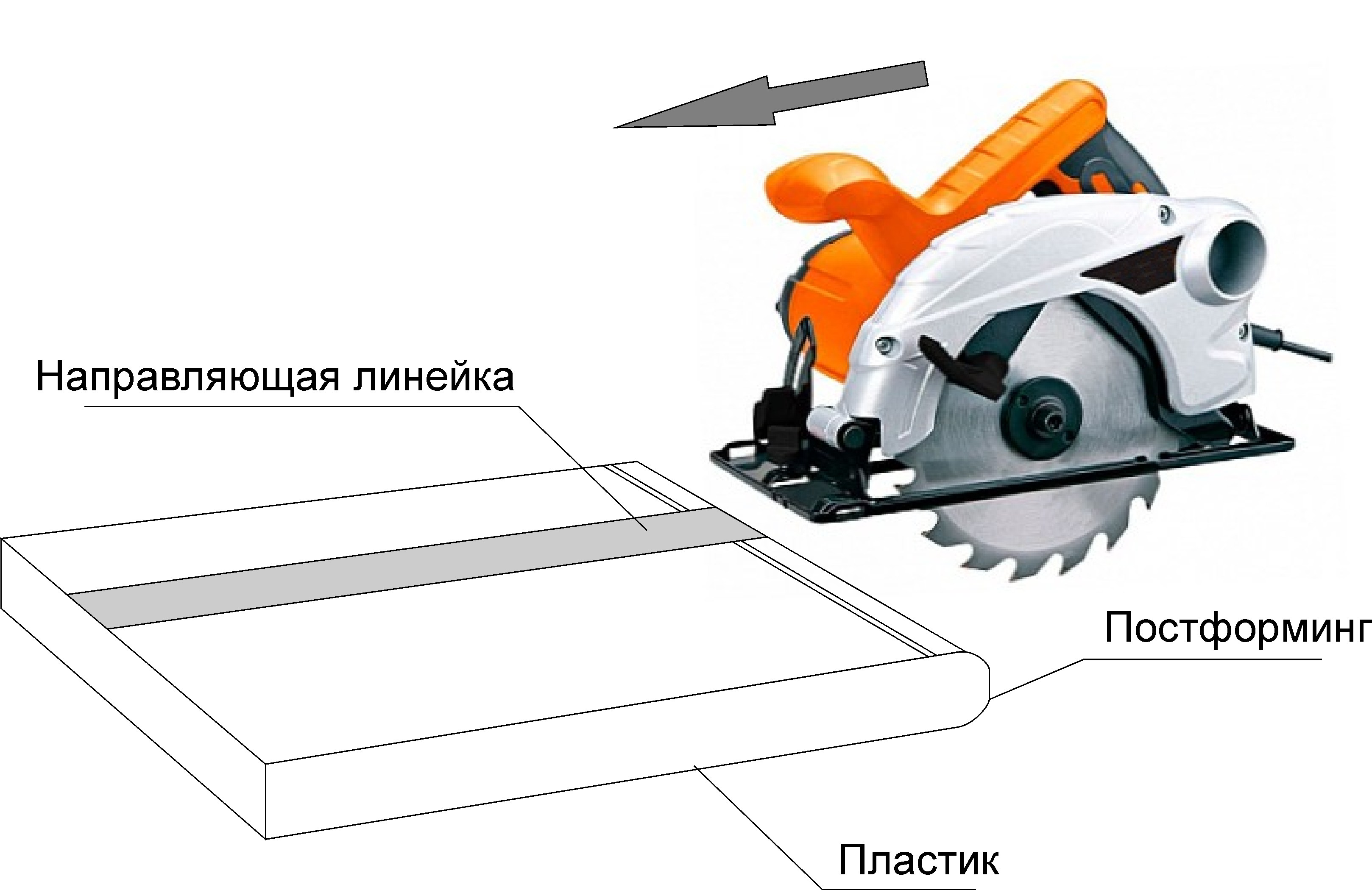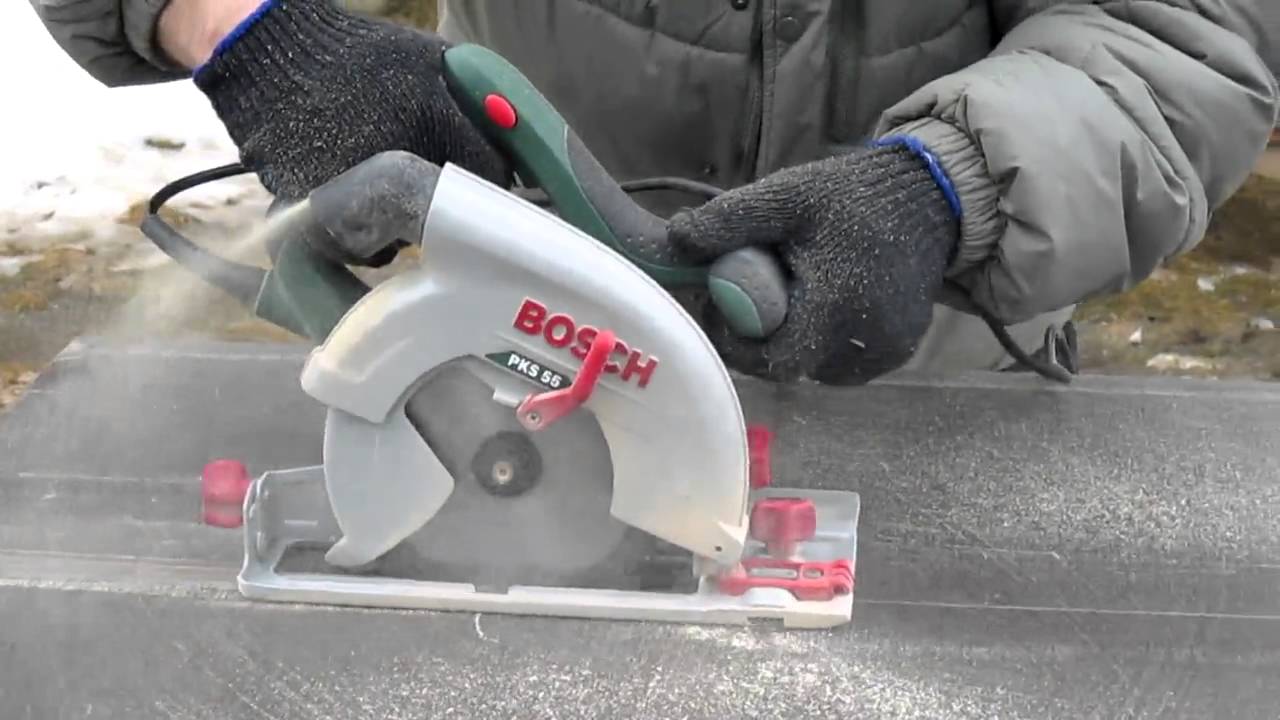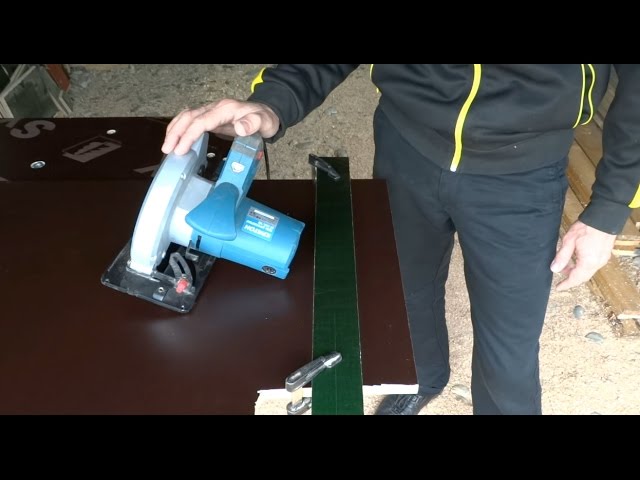How to cut wood chipboard
Chipboard can be cut with a hand saw with a fine tooth, jigsaw, circular saw. The place of the cut is glued with masking tape and cut along the cutting line with a sharp knife. The knife cuts through the laminate and the top grain of the wood underneath. Further, when the saw passes, the chipboard will not chip. Finishing the end under the C-shaped overhead edging in the manufacture of furniture, this method is quite suitable. And under the melamine self-adhesive tape, it is better to use another method.
With an electric jigsaw or a circular saw, we saw wood chipboard with a margin of 2-3 mm. from the cutting line. I sawed with a jigsaw along the guide. Any flat rail or rule can be used as a guide. In my case, fiberglass with a width of 150 mm. thickness 4 mm. As described above, chips formed on the chipboard.
Next, set the guide exactly along the cutting line and remove these 2-3 mm with a manual router with an edge mill. which we left in stock. The design of the beveler has a bearing on the shank equal to the diameter of the cutter itself, resulting in a perfectly flat edge to which self-adhesive melamine tape can be easily glued. Also, when cutting curvilinear cuts, you cannot do without the use of a router. With an electric jigsaw, we make a guide with the required radii and also go through the end with an edge mill. The chip-free sawing method is also suitable for cutting laminated plywood and MDF.
If you have tried to cut chipboard at home at least once, then you know for sure that this work is by no means simple and requires not only skill, but also a good tool. It is especially difficult to process laminated chipboard, when sawing which often a lot of chips are formed. That is why, when faced with such a problem, many craftsmen come to the conclusion that it is better to cut the chipboard when buying, especially since many trading organizations provide such services and the price for them is quite acceptable.
Sawing of chipboard is carried out using precise panel saws, which will help to obtain workpieces of a given size and shape.
In addition to cutting sheets, they will help you calculate and provide in the form of a visual video file several options for competent and economical cutting of sheet material (using special computer programs) and, if necessary, perform edging. However, if for some reason you prefer to do this work yourself, you will have to do some preparatory work before sawing the chipboard.
What affects the quality of the chipboard cut?
In this case, we will cut chipboard, this is the most capricious material for sawing, because it has longitudinal and transverse layers, a rather delicate and thin veneer. But on the other hand, it has a tough adhesive base, which will also interfere with us.
Saw blade. How to choose it?
When cutting chipboard, the saw blade must simultaneously cut cleanly and be resistant, because the glue in its properties is very close to glass and quickly blunts the tool itself. Therefore, in the process of cutting chipboard, you need to choose sufficiently good discs to cut them without losing quality for a long time.
What is the difficulty of sawing with a circular saw with discs?
If we look at the cut of the workpiece, we will see that it is full of seizures, because it is practically impossible to keep the saw straight in the cut by hand.
On the saw blade there is a difference in height between the body of the saw itself and the sawing part - the tooth. Due to this distance, the disc is able to guide its position in the cut. Accordingly, as soon as it changes its geometry, the rear teeth begin to press on the chipboard workpiece and leave traces on it.
It is important to have the workpiece face down. Why?. The disc rotates from the bottom up, it cuts the pile of the workpiece up to the base
Thus, below, on the front side, we always have a clean surface. Problems begin to form at the top, where the teeth come out of the workpiece. This is how explosions, chips, pile are obtained.
The disc rotates from the bottom up, it cuts the pile of the workpiece up to the base. Thus, below, on the front side, we always have a clean surface. Problems begin to form at the top, where the teeth come out of the workpiece. This is how explosions, chips, pile are obtained.
How can they be minimized, or avoided altogether? There are several simple tricks and we will tell you about them now.
Tools and materials
If possible, it is best to cut the chipboard with a hand milling cutter, using homemade guides. This method is not very convenient when cutting large sheets, because when working with this tool, a table is required. In addition, with this method, the cutters have to be changed frequently. But as a result, you will get cleanly processed, "chamfered" edges.
The electric jigsaw is the most popular tool for sawing chipboard
Some craftsmen use a jigsaw in their work, however, in the absence of skill, it is difficult to cut exactly, and chips can form.
You can try to install a bimetallic blade with teeth pointed inward, intended for a laminate, on a jigsaw. Cutting with a jigsaw should be increased by increasing the speed, with a small feed, so that breaks do not form.
If such methods do not suit you, then for cutting chipboard at home, we will prepare for work:
- a hacksaw with fine teeth (one that is best suited for metal work). In this case, the teeth must be divorced by 1/2 of the blade thickness and be hardened;
- paper adhesive tape;
- file for rough processing of the cut line;
- sandpaper for finishing the cut line.
Handy tools
You can cut wood chipboard and a jigsaw, but this will be a rough cut. The edges may not turn out straight, but sinusoidal, and in the worst case, the edge will come out non-perpendicular to the front surface.
In the course of cutting, one must be prepared for the jigsaw blade to start "walking" because of the bend. You need to cut with a margin of 4 mm, and then level the edge.
Sawing chipboard at home using a jigsaw, reduces the formation of chips. When cutting, it is necessary to increase the speed and reduce the feed, setting the pumping rate to 0. Only sharp saws should be used, intended for special sawing of chipboard. Only by observing these rules can you achieve a good result. After cutting, the butt, which will be in sight, can be earned with sandpaper. Additionally, before cutting, as already mentioned, you need to cut a line along which the sawing will pass. But we do not lead the file along this line, but near it - then the chips will not touch the limits you need. At the end, all that remains is to finish the edges with sandpaper.
Offsets from the contour can be up to 4 mm. Then these few millimeters are removed with a cylindrical cutter using a hand-held electric milling cutter with a bearing. The bearing is guided along a long level fixed on the back of the sheet.
In order to avoid problems with chips, it is recommended to use (where possible) a flexible overhead P-profile. It covers chips well.
In addition, if the chips are in a non-working, hardly visible area, they can be masked with a marker or felt-tip pen matched to their color.
The most undesirable way to cut wood chipboard is with a file (oddly enough, in old textbooks a lot of material is devoted to this method). It is possible with a plane, but preferably electric and with carbide knives. But here it must be borne in mind that dust from under the plane will scatter throughout the room.
And the most comfortable way is with a hand-held router along the guide.The end should be flat and under 90 grams, there will be no chips, and when the vacuum cleaner is turned on, there will be almost no dust.
Types and operational parameters
Like almost all construction equipment, circular saws are divided into professional and household. These two types differ in terms of service life and quality of operation, as well as, as a consequence, in their cost.
For example, a professional tool is designed for long and intensive work, and the frequency of household use is often limited, since a circular saw can be claimed to be used less often.
The second thing you need to pay attention to is the length of the intended cut of the board. The standard parameters of this criterion are 50-60 millimeters, which ensures greater maneuverability of the saw.
But there are also exceptions. For example, to work with thin material, a tool with a disc of 30-40 millimeters is used, and, on the contrary, large saws in wood of 90-100 millimeters and more have been developed for thick boards.
If you need a tool that combines different sizes of discs, then you can purchase a device with the possibility of permanent installation. It has a plus - less weight than devices with the same 100 millimeters.
The size of a hand saw blade also dictates its power - low, medium power or high power. Professionals, in the case of household work, recommend giving preference to the second category, in which overheating and failure of sometimes quite expensive equipment are unlikely.
Ways to minimize chips
An additional reason for the formation of chips can be the spread of the teeth of the file. Therefore, the first step is to take care of purchasing a tool with a straight cut (often Bosh files). However, it should be borne in mind that with prolonged work, such files overheat and may even bend during the cutting process. Therefore, it is necessary to take breaks in work to cool down the cutting tool.
However, replacing the file alone is not enough, and in order to cut the chipboard (laminate) with an electric jigsaw without chips, it is necessary to perform a slight modification of the power tool. Namely, to make sure that when the file moves against the inclination of the tooth, the material does not break out. For which it is enough to make a persistent platform. You can come to this conclusion by trying to cut through two sheets of chipboard at the same time. So there will be practically no chips on the lower element.
In order to make a thrust platform for a jigsaw, it is enough to cut out a rectangle in dimensions identical to the dimensions of the sole of the power tool from any dense material (for example, from a laminate).
Then, along the larger axial line, a cut should be made and the resulting equipment should be fixed to the sole of the jigsaw using electrical tape or double-sided tape. All revision is ready and you can carry out finishing work in compliance with certain recommendations.
First, as mentioned above, you should use a jigsaw file with a straight cut.
Secondly, in order to better control the cutting process, it is justified to apply a marking line on both sides of the chipboard and check the processing accuracy from above and below.
And thirdly, to take constant breaks from work to cool the cutting equipment.

Sometimes the solution to this issue can be a simple cutting of the leminated layer of material using an assembly knife, and subsequent work with a jigsaw will no longer cause large defects in the form of chips. However, this work requires a certain amount of experience and accuracy from the performer.
How to cut wood chipboard
Chipboard can be cut with a hand saw with a fine tooth, jigsaw, circular saw. The place of the cut is glued with masking tape and cut along the cutting line with a sharp knife. The knife cuts through the laminate and the top grain of the wood underneath. Further, when the saw passes, the chipboard will not chip.Finishing the end under the C-shaped overhead edging in the manufacture of furniture, this method is quite suitable. And under the melamine self-adhesive tape, it is better to use another method.
With an electric jigsaw or a circular saw, we saw wood chipboard with a margin of 2-3 mm. from the cutting line. I sawed with a jigsaw along the guide. Any flat rail or rule can be used as a guide. In my case, fiberglass with a width of 150 mm. thickness 4 mm. As described above, chips formed on the chipboard.
Next, set the guide exactly along the cutting line and remove these 2-3 mm with a manual router with an edge mill. which we left in stock. The design of the beveler has a bearing on the shank equal to the diameter of the cutter itself, resulting in a perfectly flat edge to which self-adhesive melamine tape can be easily glued. Also, when cutting curvilinear cuts, you cannot do without the use of a router. With an electric jigsaw, we make a guide with the required radii and also go through the end with an edge mill. The chip-free sawing method is also suitable for cutting laminated plywood and MDF.
Everyone knows that laminated chipboard is our chipboard, which is covered with a paper-resin film. The lamination process takes place under special conditions: pressure 25-28 MPa, temperature 140-210 ° C. The surface is solid, smooth and beautiful. The laminated chipboard coating is very resistant to mechanical stress and thermal. Because of these qualities, laminated chipboard has become simply necessary for furniture production and for interior decoration.
Some craftsmen like to make furniture on their own. They purchase good quality laminated chipboard from manufacturers or in special hardware stores. Since the color gamut of chipboard is very rich, you can easily choose the right material. The surface of laminated chipboard also has the most diverse structure, since it is smooth, imitating wood of different species or stone.
In order to make special furniture or a unique interior with your own hands, it is not enough just to buy chipboard and draw it into details. Chipboard coating is very thin, its structure is fragile. If you cut the chipboard roughly and incorrectly, the cut will turn out to be ugly, torn, and shells form on the edges. To be able to cut the chipboard correctly and not get chips and cracks, you need to know some little "tricks" of the work.
Chipboard sawing rules
To cut the chipboard at home, use a hand saw with fine teeth, a circular saw or an electric jigsaw. To get the job done without problems, you need to do the following:
- Attach tightly adhesive tape exactly along the cutting line. The tape will prevent the saw teeth from damaging the coating film.
- Use a sharp knife to cut through the cover and the layer below it along the cutting line. In this case, the saw will cut only the inner layer of the chipboard, and only touch the coating tangentially.
- The hand saw, when handled, should be positioned at an angle (very sharp) to the surface of the board.
- For cutting with an electric tool, use the minimum feed.
- When the part is cut, you need to cut the edge of the cover at an angle of 45 ° with a sharp knife.
- The cut is sanded with a fine file, the cut is processed towards the center from the edges.
The edge of the sawn chipboard should be covered with a special overlay so that in the future it does not get any chips or cracks. To protect the saw cut, you can use self-adhesive melamine tape, or a C-shaped patch piping, or a T-shaped edge.
It is extremely rare when performing repairs using chipboard plates it is possible to do without cutting the material. Unfortunately, often the owners cannot cut the chipboard so evenly that chips or other damage does not remain. But with a competent approach to holding such an event, it is still possible to get quite a good result. To do this, follow these steps.
Professional and household circular saws
Circular saws allow you to cut with maximum angle accuracy and an even edge. However, some materials may require guides. By the way, only professional tools are equipped with guide rails. There are models in which the guides are integrated into the design of the saws themselves.
Circular saws for professionals are equipped with a powerful motor that allows the saw blade to rotate at high speeds
An important characteristic of such saws is considered to be the cutting depth. Depending on it, saws are divided into small, medium, large and professional
For domestic use, it is recommended to choose small and medium circular saws with a maximum cutting depth of 55 mm. For production purposes, only large saws should be used. Their cutting depth can be up to 70 mm. Plus, large saws can cut both thin and thick material. In the woodworking industry, professional saws with a cutting depth of up to 140 mm are usually used.
Pipe cutting at an angle of 45 and 90 degrees
If you need to cut the pipe at an angle of 45 degrees, which is more often required when laying water, heating pipes. Steel, cast iron pipes that are cylindrical in shape are often used. In installation work, rectangular or shaped pipes are used. However, you should correctly cut the pipe with a grinder, so that later it can be easily connected. Therefore, you should carefully mark the pipe.
Some craftsmen try to mark the place of the cut using a tape measure, but we warn you that the result is likely to be negative. And for a positive result, consider the following professional recommendation.
Take a sheet of paper or cardboard, preferably A4, fold it diagonally and wrap it around the pipe where you plan to cut it evenly. The edges of the paper must be in perfect alignment with each other. And the side of the paper that is closer to the end of the pipe was perpendicular to the axis. Then mark the cutting line in a circle.
If you need to cut exactly at an angle of 90 degrees, then solve the problem quickly using paper or masking tape again. Wrap around the pipe so the ends match. Make even lines and saw off.


How to cut a profile pipe straight?
Masters advise using a square when cutting a profile pipe. To do this, apply the square in turn to the sides, and turn and mark with smooth movements. After action, fix the pipe and cut. Prepare yourself a template that will come in handy in the future and save time. It is better to perform the action with a grinder, so the cut will be smoother.
How to cut a cast iron pipe?
When working with a cast iron pipe, keep in mind that it is a brittle material. Therefore, let us point out a method with which it will be possible to cut such a metal without damage.
Before starting work, make notes for the cut, as with steel pipes. Place a piece of wood for support. Work the grinder around the circumference of the pipe, making small cuts. Then take the chisels, insert into the groove and hit hard with a hammer. Note that bakelite-based cut-off wheels are used to cut cast iron pipes.
If you don't have a grinder at hand to cut a cast-iron sewer pipe or other purposes, use a metal hacksaw, chisels or special pipe cutters.
How to cut a gas pipe?
Cutting a gas pipe is dangerous, so it is best to entrust it to professionals. But if you are confident in your strength, then take a grinder, welding, hacksaw, gas welding to cut the metal.
Pruning instruction:
- Shut off the gas riser before work. Then release the rest of the gas from the pipe. To do this, light the gas in the burners and wait for it to go out.
- After the actions taken, cut. Using the welding method, the metal base burns out when exposed to high temperature.The result is fast and effective. But remember that cutting or rooting gas pipes again takes experience.
Methods for cutting large diameter pipes
There are a number of reliable tools available for cutting large diameter pipes such as sewers. Next, we will consider some of them in detail:
The grinder is an inexpensive and affordable option, but it is considered not the safest when working with such materials. Once you decide to use this method, then be careful and use protective equipment.
A roller machine (pipe cutter) is such a tool adapted for such manipulations. The device is attached and material removal begins. The clamping force is adjusted by means of mechanical devices
It is important to note that the models of the machine differ in shape, so consider the ratio of dimensions to the pipe before use.
Flame cutting is the most popular option for cutting large diameter pipes, sheet metal. The cut occurs due to the action of a high intensity flame, the metal melts and leaves the cut zone with a gas flow
This method is convenient and effective.
How to cut the pipe lengthwise correctly?
A quick way to cut a pipe lengthwise using a grinder:
Focus on the markup.
Use for such a case the painter's thread, which has found widespread use when marking walls.
Before starting work, fix the pipe and with small movements, carefully saw the pipe.
Better not to rush, but delicately and slowly process the parts of the pipe, so the cutting disc will not jump off the marking lines. Remember safety ... How to cut thin-walled pipes?
How to cut thin-walled pipes?
Thin-walled pipes are made of non-ferrous metals: aluminum, copper.
Rules for the safe operation of an electric circular saw
When purchasing this power tool, you should pay attention to the safety criterion. Absolutely all conscientious manufacturers of such equipment "wrap" the cutting disc with a protective cover, which can protect fingers, parts of gloves or other materials from getting under the cutting device, preserving the health of its owner
The cover always covers the upper part of the saw blade facing the face of the person working with the circular saw, and the lower part is "exposed" only during direct cutting.
The first quality of protection will also be able to protect the face, body and other parts of a person's face from chips.
Another safety measure is to protect the device from being accidentally turned on. Only after pressing the start button together with the deactivation of this option, the saw will start working.
You should not be afraid of jamming a circular saw, since almost all modern manufacturers in their equipment have provided for such a possibility, when the cutting wheel stops rotating, but the engine does not turn off, after which the saw can be removed from the problematic cutting area and start over.
How to cut chipboard with a jigsaw without chips
Such work should be done delicately, since there is a high probability of deformation of the material. Fillers such as sand are used for cutting. Actions can be carried out using a grinder, a special machine.
Summing up, we emphasize
that cutting metal pipes is a complicated process, but everyone can enhance it. With the advice of a professional, you can easily cut pipes in a variety of sizes and materials. Also remember to file or sandpaper the edges of the pipes after cutting. And the most important thing to remember when starting such actions is safety precautions. Wear a special suit (casing), mask or goggles when getting started. Hands should also be reliably protected from sparks, so use thick gloves.
What can not be sawed chipboard
If the volume of work is large enough, and the quality requirements are small, some craftsmen advise to saw the chipboard at home using a grinder (angle grinder, commonly called a "grinder"). In doing so, they use a disc designed for working with wood. To make cutting easier, a guide bar is fixed with clamps along the cutting line. Sawing chipboard using a grinder can sometimes be seen in the video.
The easiest way to mark up is to draw straight lines along the sides of the slab using taut threads, a square, a ruler and / or a measuring tape. In the presence of a large number of cut parts, it is difficult to choose the optimal sheet cutting pattern that can reduce losses due to the remaining scraps. To outline smooth bends, you need to use templates that allow you to reproduce numerous fragments of the same type.
Special programs help to improve the quality of cutting, in which the sizes of products are set, a calculation is made and a diagram of the optimal arrangement of cutting lines is displayed. These programs include "Cutting 2", "Master 2" and others.
An example of using the software is shown in the video:
When cutting the material with your own hands, you need to pay special attention to the straightness of the corners and maintaining straight lines. Large sheets should be marked on the floor, working in pairs.
One-person delineation of dimensions is fraught with parameter distortion caused by the displacement of the measuring instruments during operation.
Ways to cut chipboard
The main tools for cutting wood-based panels are:
- hand saw for wood or metal;
- electric or conventional jigsaw;
- Circular Saw.
The cuts are more accurate with a metal hand saw and jigsaw. The disadvantages of the saw include its low productivity, which is unacceptable for working with large volumes of chipboard. The use of a jigsaw does not allow obtaining straight cut lines, compared to a circular saw.
Working with a jigsaw does not always prevent chipping at the end of the slab. Only the use of high-quality canvases can create a straight cut line.
To reduce the number or even avoid chips when processing chipboard, you can use a special technique for working with a conventional circular saw. First, strict markings are made, mirrored on different sides of the material. Then, according to this marking, grooves are cut on each side, entering into the depth of the slab by about 60-70% of its thickness (the material is cut completely in two passes).
Since surface chipping occurs at the exit of the teeth rather than at the entry, two-pass sawing virtually eliminates material damage. This method requires a high precision cut to produce a smooth end face. The saw blade for chipboard should have a small serration to reduce the area of interaction with the pressed wood chips.
The use of a sawing machine greatly facilitates the cut in two approaches. A number of parts can be made by cutting out a workpiece with deliberately oversized dimensions (by 5-10 mm), after which they are cut on both sides according to the specified parameters. The use of a sawing machine allows you not only to maintain accurate dimensions, but to cut exactly the lines required for the manufacture of prefabricated structures.
Some sawing machines support self-marking of the slab. The complete set of such machines includes clamps and rails that facilitate precise cutting.
How to cut off the chipboard smoothly and without chips can be seen in the video:



